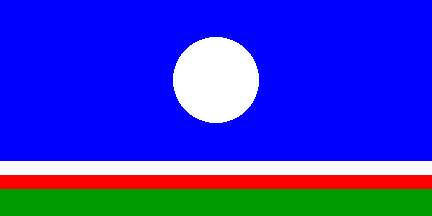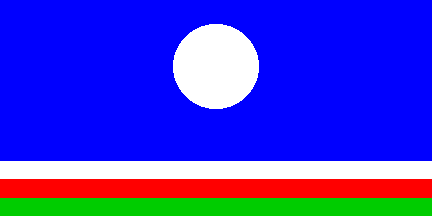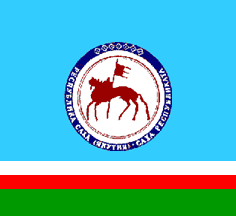
Last modified: 2007-06-16 by antónio martins
Keywords: caxa | saqa | sakha | yakutia | sun: disc | sun (white) | disc (white) | purity | snow | hope | wisdom | kindness | strength | courage | honour | sovereignty | health | joy | president | petroglyph | tongues: 3 | urunwkun |
Links: FOTW homepage |
search |
disclaimer and copyright |
write us |
mirrors

(Note: You need an Unicode-aware software and font to correctely view the cyrillic text on this page. See here transliteration details).
Yakutia is located on north-eastern Siberia. Its area is 3 103 200 km2, that is 18,2% of the total area of the Russian Federation and nearly the area of India. Yakutia is bordered in the north by the Arctic ocean and its southern limit lies some 250 km north of China. From west to east, Yakutia includes the basins of five big rivers, Oleniok, Lena, Yana, Indiguirka and Kolyma, spreading over two time zones.
The capital city of Yakutia is Yakutsk , one of the most isolated cities in the world — 6000 km from Moscow, 2000 km from Japan and 3000 km from Alaska.
The climate of Yakutia is extremely harsh with big temperature variations (from −60 °C in winter to +40 °C in summer); the lowest temperature ever recorded in the northern hemisphere is −72 °C in Oimiakon, in eastern Yakutia.
Yakutia is mostly covered by taiga, tundra and mountains. Permafrost (that is soil constantly and deeply frozen) covers 95% of the country. Yakutia produces 99% of the Russian production of diamonds, that is 12% of the world production, as well as 25% of gold and 100% of antimony in Russia, tin, wolfram, coal, natural gas etc..
Yakutia was originally settled by communities of Paleoasiatic (Koriaks, Chukchs, Yukaguirs) and Tungunso-Manchu (Evenks, Evens) hunters and reindeer breeders. The Yakuts (Sakhas), horse and cattle breeders of Turco-Mongol origin, colonized the country in the XVth century and remained numerically dominant until the 1930s. The Russian colonization started in the XVIIth century.
Ivan Sache, 15 Apr 2006, quoting from Marine Le Berre-Semenov’s website
An ASSR for the Sakha people was created in
1922. In 1991, this republic unilaterally upgraded its status to a full
Union Republic.
Stuart Notholt, 13 Oct 1995
The ASSR of Yakutia was created in 1922 by the Soviet rule. The successive waves of political deportations and the massive colonization triggered by the mineral resources caused in the second half of the XXth century a strong increase and diversification of the population.
In 1989, the population of Yakutia was estimated at 1 000 000, including 50% of Russians, 33% of Yakuts, 7% of Ukrainians and 2,3% of autochtons. Some 100 nationalities were recorded.
In 1990, Yakutia proclaimed itself «sovereign within the Russian Federation», claiming a real economical, cultural and political autonomy. Two years later, Yakutia was renamed Sakha and adopted national symbols: a flag, a coat of arms and an anthem. In 1995, following the example of Tatarstan and Bashkotorstan, Sakha set up bilateral relations with Russia, based on treaties and agreements.
Ivan Sache, 15 Apr 2006, quoting from Marine Le Berre-Semenov’s website
The flag of the Republic of Sakha is light
blue, with a white disc and, at the bottom of the
flag, three narrow stripes of white, red and green.
Stuart Notholt, 13 Oct 1995
At www.yakutia.ru/~pages/koi7/win/koi7/koi7/minvs/Russian-Guide/Text/1GeneralSurvey/11-2.htm, there’s an unusually clear and concise construction prescription (in russian but spelt in latin letters); I’ll summarize it:
The flag has a ratio 1:2, and is made up of four rectangles, placed horizontally: from top to bottom: light blue, white, red and green. The light blue stripe has a height of 3/4ths of the flag height, white 1/16th, red 1/16th, and green 1/8th. In the middle of the light blue rectangle, a white disc whose diameter is ²/5 of the flag height.(The placing of the disc is further and redoundantly defined as being the disc’s center in the same point as the intersection of the diagonals of the light blue rectangle.)
It was adopted by Law #1158/XII (14.10.1992).
Victor Lomantsov, 30 Apr 2000
The flag of the Republic of Sakha has certain semantic
meaning:
sun - sky - snow - flowers - ground
Oliver Apper, 02 Apr 1998
The flag of Sakha Republic was adopted in 1992. Its symbolics is explained
by Uliana Vinokurova, Yakut ideologist and politician, in her book Skaz o
narode sakha (The story of the Sakha people), published in 1994. The flag
of Yakutia-Sakha reflects the national traditions of the Sakhas: a white sun
(урунъкун), symbol of
eternal life, on a blue field, caracterizing the polar climate, cold and hard,
of the Sakha country. In the bottom of the flag, three coloured stripes, white
for purity, snow, hope, wisdom and kindness; red for strength, courage, honour
and aspiration to sovereignty; green for health, joy, and hope put into the
active forces of the nation.
Ivan Sache, 15 Apr 2006, quoting from
Marine Le Berre-Semenov’s
website

Law of flag of Sakha say light blue, but in fact in the
manufactured flags is used the blue of the russian flag (a bit dark).
Jaume Ollé, 11 Sep 1999

Note that the illustrations of the
referred page
show a flag with the three lower stripes of equel height and the white
disc shifted to the top of the flag.
Ivan Sache, 23 Apr 2000
This flag was adopted in 23-9-92. In 14 october 1992 (Law 1158/XII) the
flag was slighty modified. The green stripe was a bit more wide (1/8) the red
and white 1/16 and the blue c. 3/4. White disk 2/5 (Source Vexilologie
[vex] 87).
Jaume Ollé, 19 Apr 2000
What were the specifications in that first law? And (probably more
difficult to find out) were any flags produced according to the old specs
during those three weeks?
António Martins, 01 May 2000
![Yakutian flag in [eba94]](../images/r/ru-14_a.gif)
This flag (in light blue and with incorrect stripes)
is listed under number 128 at the chart Flags
of Aspirant Peoples [eba94] as:
«Sakha Omuk [Sakha Respubli Kalar] (Sakhas [Yakuts]) - North
Siberia».
Ivan Sache, 15 Sep 1999

The Presidential flag shows the seal
(playing the role of coat of arms) of Yakutia.
António Martins, 02 Oct 2005
Presidential Standarts are accepted at a
legislative level in many Republics both some Oblasts and Autonomous Regions
(In laws of Republic Sakha (Yakutia) such symbols are named auxiliary
state symbols).
Sergey Filatov, 10 Oct 2005
The Law Of The Republic Sakha (Yakutia)
About Official Symbols In Republic Sakha (Yakutia)Chapter 5. Auxiliary State Symbolics, Municipal And Other Symbolics
Article 26. Auxiliary state symbolic
2. Symbols of the President of Republic Sakha (Yakutia) are a ceremonial pin and standart of the President of Republic Sakha (Yakutia).
Standart of the President of Republic Sakha (Yakutia) is represented a square panel of colors of the national Flag of the Republic Sakha (Yakutia) with the image of the State Emblem of Republic Sakha (Yakutia) carrying instead of a white circle. The original standart of the President of Republic Sakha (Yakutia) is made out by a fringe, attached to a staff with figured overhead, constantly is in its study and settles down on the right (from the point of view of the observer) from the national Flag of Republic Sakha (Yakutia). Executed in identical or other engineering and the size the duplicate of the original standart of the President of Republic Sakha (Yakutia) (the square flag reproducing a composition of the original) rises or hung out above the basic president residence of Republic Sakha (Yakutia) and in other places of official stay of the President of Republic Sakha (Yakutia).
Most of these flags are squarish (about 11:12),
rigid and fringed variants of the region (Governors) or Republic (Presidents)
flags with the regional emblem over all.
António Martins, 02 Oct 2005

The coat of arms of Sakha Republic is based on a rock painting. It shows
a Sakha rider bearing a standard symbolizing the
unification of the tribes and charged with as many stars as the autochtonous
nations in Yakutia.
Ivan Sache, 15 Apr 2006, quoting from
Marine Le Berre-Semenov’s
website
The Presidential flag shows the seal
(playing the role of coat of arms) of Yakutia. This includes an image of a
rider, taken from an ancient painting. He holds a monochrome
flag with three long tongues extending from its flag.
António Martins, 02 Oct 2005
This is a reconstruction of petroglyphe of ancient tribes. To science it is
not proved, that this figure on a stone (petroglyphe) has the direct relation
to Nation of Sakha (Yakuts). It is obvious, that given vexilloid there is a
banner.
Mikhail Revnivtsev, 03 Oct 2005
I don’t know the age of the original rock painting, but it might be one
of the oldest known representations of a flag.
Ivan Sache, 15 Apr 2006
At the official
website, this emblem is described in some detail. The colors given are
dark red
(тёмно-красний)
and a curious dark “light-blue”
(тёмно-голубой).
António Martins, 02 Oct 2005
.gif)
The knight in the seal holds a monochrome flag with
three long tongues extending from its flag. This is either a contemporary
depiction of an ancient flag, an attempt of reconstructing one, or a
“legitimate” artist’s impression (which would make this
a flagoid, popping into existence from
its representation in a recognized emblem.)
António Martins, 02 Oct 2005
Anything below this line was not added by the editor of this page.